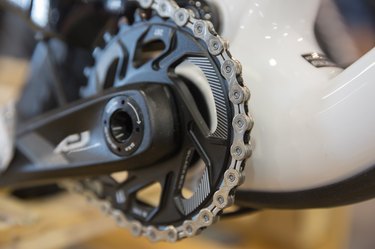
Bicycles have two types of cranks, cotterless and cottered. Cottered cranks are often found on older bicycles, and you can identify these from the cotter bolts that thread through the top of the crank arm. A cotterless crank has a hex bolt in the center top of the crank arm. Regardless of type, check your crank every other month to keep the crank tight.
Cotterless Cranks
Video of the Day
Step 1
Pry the plastic protector cap from the crank arm with a wide-bladed slotted screwdriver. The protector cap covers the hex-head bolt that holds the crank arm to the crank and keeps the crank tight. Some older bicycle models may have a threaded dust cap, and you can remove the dust cap with a hex key.
Video of the Day
Step 2
Insert a hex key into the hex-head bolt. If you have an older, male-threaded spindle, fit a metric socket and socket wrench over the bolt. Turn the bolt clockwise to tighten the crank.
Step 3
Replace the plastic protector cap onto the crank arm.
Step 4
Tighten the other side of the crank by repeating the steps on the opposite crank arm.
Cottered Cranks
Step 1
Remove the nuts from the cotter bolts that thread through the crank with an adjustable wrench. A worn cotter can cause a loose crank.
Step 2
Position a cotter pin press over the crank with the bolt attached to the press against the threaded end of the cotter bolt. Finger tighten the press bolt clockwise on the cotter pin press until you can no longer turn it with your fingers. Continue to turn the cotter pin press bolt with an adjustable wrench to push the cotter bolt from the crank.
Step 3
Cut a short piece of metal pipe with a hacksaw to fit the distance from the floor to the crank if you do not have access to a cotter pin press. Position one end of the pipe where it sits over the non-threaded end of the cotter bolt. Wedge the opposite end of the pipe against the floor to support the crank. Strike the threaded end of the cotter bolt as hard as possible with a hammer to drive it from the crank.
Step 4
Position a drive pin punch against the cotter bolt if the end is sheared off from damage or from attempting to drive it from the crank with a hammer. Hold the drive pin punch with vise grip or locking pliers to keep from accidentally hitting your fingers. Strike the dive pin punch with the hammer until it drives the cotter bolt from the crank.
Step 5
Drill a 1/4-inch hole into the center of the cotter bolt with a 1/4-inch metal drill bit and a power-drill if the drive pin fails to drive the cotter bolt from the crank. Place the drive pin punch against the cotter bolt once again. Strike it with a hammer to push the cotter bolt from the crank.
Step 6
Heat the crank with a propane torch as a last resort if all other options have failed to remove the cotter bolt. Don't heat the crank so much that it becomes red hot, only hot enough where you could no longer touch it. Place the drive pin against the cotter bolt once again and strike it with a hammer to remove it from the crank.
Step 7
Apply axle grease to a new cotter bolt. Position the cotter pin press over the crank with the bolt attached to the cotter pin press against the non-threaded end of the cotter bolt. Finger-tighten the press bolt counterclockwise on the cotter pin press until you can no longer turn it with your fingers. Continue to turn the cotter pin press bolt with an adjustable wrench to push the cotter bolt into the crank. Insert the cotter bolt into the crank and tap it into the crank with the hammer if you do not have a cotter pin press
Step 8
Place the nut onto the cotter and tighten it with the adjustable wrench. Do not over tighten the nut, as you could strip the threads on the bolt.
Things You'll Need
Wide-bladed slotted screwdriver
Metric hex-key set
Metric socket set
Adjustable wrench
Cotter pin press
Short pipe piece
Hacksaw
Hammer
Drive pin punch
Vise grip or locking pliers
1/4-inch metal drill bit
Power drill
Propane torch
Axle grease
Replacement cotter bolt
Metal file
Tip
File the flat side of the cotter bolt with a metal file if you cannot get the cotter bolt to fit inside the crank.
Use thin wall sockets if you have difficult fitting the socket over the crank bolt on older male-threaded spindles.
When replacing more than one cotter bolt on a crank, make sure they face opposite directions, so the nuts are not on the same side of the crank.
- BikeWebSite: Bicycle Tune-Up Step 2 - Bottom Bracket Adjustment
- BikeWebSite: Diagnosing Noises
- SheldonBrown.com; Tool Tips: Cotterless Cranks; Sheldon Brown; July 2010
- SheldonBrown.com; Cottered Cranks; Sheldon Brown; November 2010
- UtahMountainBiking.com: Crank Removal and Replacement
- UtahMountainBiking.com: Old-Style (Male-Threaded Spindle) Crank Replacement